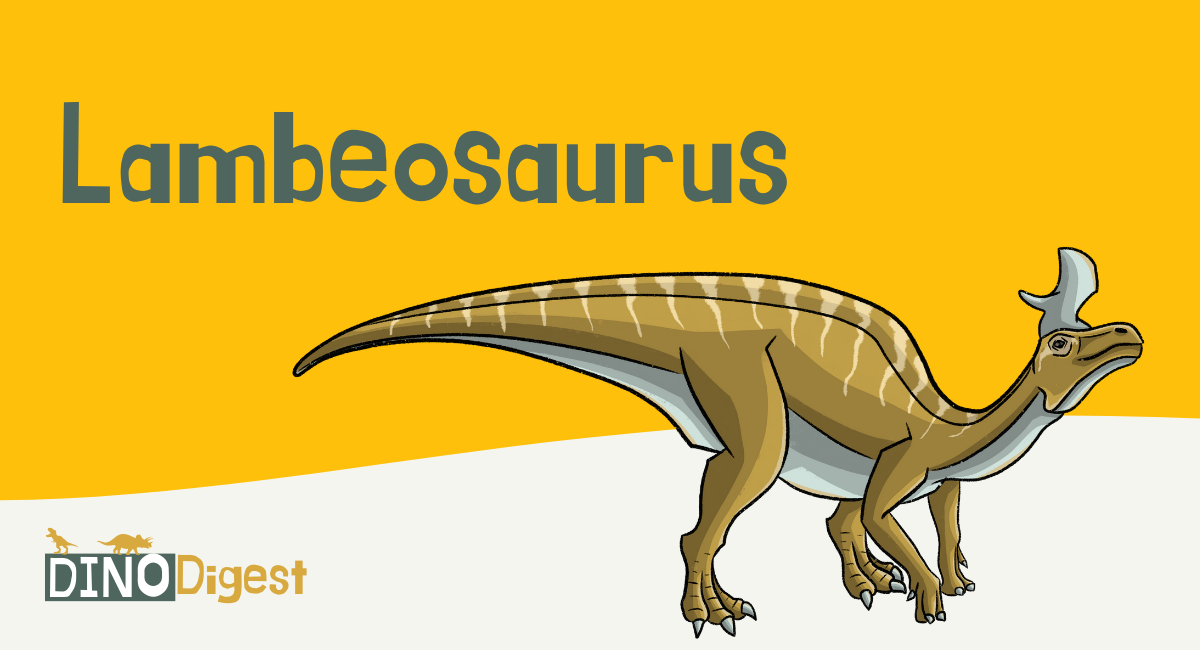The Lamebeosaurus was a late Cretaceous dinosaur that roamed the forest of North America almost 75 million years ago. The Lambeosaurus had a crest that wasn’t decorative. This dino used it to make mating sounds or warn local dinos of nearby predators. It enhanced their sense of smell; some paleontologists believed it even helped them drink salt water.
Table of Contents
Some Quick Facts About the Lambeosaurus

| Name | Lambeosaurus (Lambe’s lizard) |
| Type of dinosaur | Hadrosaur |
| Territory | Forests, North America |
| Size | 23–25 feet long, 6 feet tall |
| Color | Brownish |
| Interesting Characteristics | Cranial crest |
| Diet | Plants |
| Major Threats | Larger theropods, natural disasters |
This Hadrosaurid weighed over 6,000 pounds and had a unique crest on its head used for various purposes.
While it was a gentle herbivore, its strong back legs allowed it to flee from predators at incredible speeds!
What Did Lambeosaurus Look Like?
The Lambeosaurus was one strange-looking dino. While it walked around on four legs (it was quadrupedal, like the Riojasaurus), its hind legs were much stronger and bigger than its small, scrawny forelimbs.
When grazing for food, it walked on all fours, but when it was being chased, it shifted its weight to its back legs to achieve high speeds and balanced on its long tail like a tripod.
What also makes the Lambeosaurus an unusual dinosaur is the duck-like snout and cranial crest on its head. It was also the dino that didn’t have any front teeth. Its crest was large and distinctive and jutted out over its eyes. The crest was similar to a rooster and is one of the Lambeosaurus’ most distinctive features.
What’s With The Lambeosaurus’ Crest?
Paleontology has a few ideas about the roles of the crest. Some believe that the hatchet-shaped crest on its head produced sounds!
Since the crest was hollow, many researchers believe that the Lambeosaurus used its hollow crest (that looked like a snorkel) to make sounds unique to fellow Lambeosauruses.
Like modern birds, it made unique mating calls to attract a female or warned nearby dinosaurs if there was a threat around.
The Lambeosaurus was a herbivore (which means it only ate plants) and was always looking over its back for predators like the Albertosaurus and Daspletosaurus. When it spotted a predator, it used its bony crest to warn nearby dinos to take cover.
How Many Teeth Did Lambeosaurus Have?
This duck-billed hadrosaur may not have had any front teeth, but it had up to 1,600 back teeth.
It used its tiny, leaf-shaped teeth to tear through the stems of tree branches and local plant life found in North America (Alberta, and Baja California).
What’s interesting about this gentle duck-billed dinosaur is that it often replaced teeth as needed. Humans have one set of teeth (outside their baby teeth), but the Lambeosaurus constantly grew new ones.
How Much Did a Lambeosaurus Weigh?
Even on a plant-based diet, the Lambeosaurus was anything but skinny. Dinos in the Mesozoic grew to colossal sizes, and the Lambeosaurus was no exception. Most weighed around 7,000 pounds, or around the same weight as seven cows.
To put that into perspective, the weight of this upper Cretaceous dinosaur was about half as much as a T-Rex, which is impressive for a plant eater.
What Did A Lambeosaurus Eat?
We know that the Lambeosaurus ate local plants, all based on the shape of its teeth.
Carnivores (or meat-eating dinos) have sharp, jagged teeth used for ripping into other dinosaurs. The Lambeosaurus has a mouth of tiny, leaf-shaped teeth perfect for grinding down plants like ferns and conifers that were plentiful in the prehistoric forests of Montana and other forests of North America.
What Was The Best Habitat For A Lambeosaurus?

As a gentle plant-eater, the best habitat for the Lambeosaurus was areas with lush vegetation, plenty of water sources, and places to hide from predators. The dense forests of North America during the Upper Cretaceous were the perfect place for the Lambeosaurus.
The temperatures were just right for native plants to thrive, and the lush forest offered protection from apex predators.
5 Fun Lambeosaurus Facts
- It could walk on two legs. While it typically walked on all four legs when grazing, it could position itself on its back legs to reach fast speeds when running from a predator. It has a top speed of almost 30 MPH, faster than Usain Bolt!
- The first fossils of the Lambeosaurus were discovered in 1914. They were found in the Oldman Formation, Alberta, Canada, by paleontologist Lawrence Lambe. That’s where the Lambeosaurus earned its name.
- See it in person! Fossils of the Lambeosaurus are on display at the Natural History Museum in San Diego.
- Lambeosaurus had similar crested relatives. Similar dinos to the Lambeosaurus include the Corythosaurus, Hypacrosaurus, and Olorotitan. These dinos were similar to the Lambeosaurus but smaller.
- The Tetragonosaurus is a Lambeosaurus. In 1920, paleontologists unearthed Lambeosaurus-like fossils in North America, classified as the Tetragonosaurus. However, it was later discovered that these fossils weren’t new. They were the fossils of a young Lambeosaurus.

